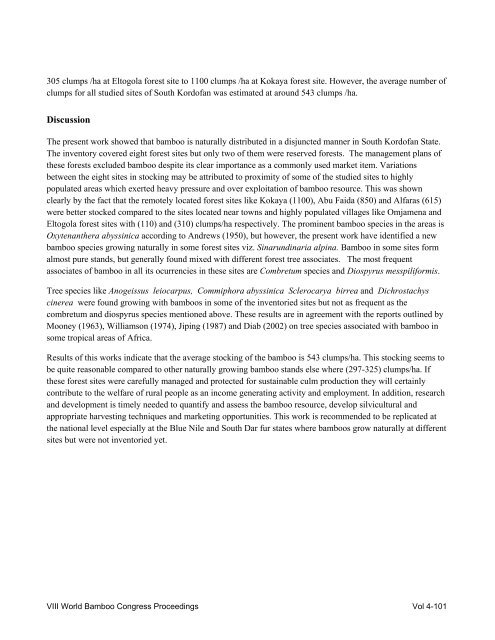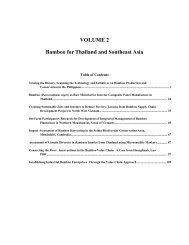WBC-VIII-Vol.4 – Resources – Forestry, Plantations and ... - BambuSC
WBC-VIII-Vol.4 – Resources – Forestry, Plantations and ... - BambuSC
WBC-VIII-Vol.4 – Resources – Forestry, Plantations and ... - BambuSC
You also want an ePaper? Increase the reach of your titles
YUMPU automatically turns print PDFs into web optimized ePapers that Google loves.
305 clumps /ha at Eltogola forest site to 1100 clumps /ha at Kokaya forest site. However, the average number of<br />
clumps for all studied sites of South Kordofan was estimated at around 543 clumps /ha.<br />
Discussion<br />
The present work showed that bamboo is naturally distributed in a disjuncted manner in South Kordofan State.<br />
The inventory covered eight forest sites but only two of them were reserved forests. The management plans of<br />
these forests excluded bamboo despite its clear importance as a commonly used market item. Variations<br />
between the eight sites in stocking may be attributed to proximity of some of the studied sites to highly<br />
populated areas which exerted heavy pressure <strong>and</strong> over exploitation of bamboo resource. This was shown<br />
clearly by the fact that the remotely located forest sites like Kokaya (1100), Abu Faida (850) <strong>and</strong> Alfaras (615)<br />
were better stocked compared to the sites located near towns <strong>and</strong> highly populated villages like Omjamena <strong>and</strong><br />
Eltogola forest sites with (110) <strong>and</strong> (310) clumps/ha respectively. The prominent bamboo species in the areas is<br />
Oxytenanthera abyssinica according to Andrews (1950), but however, the present work have identified a new<br />
bamboo species growing naturally in some forest sites viz. Sinarundinaria alpina. Bamboo in some sites form<br />
almost pure st<strong>and</strong>s, but generally found mixed with different forest tree associates. The most frequent<br />
associates of bamboo in all its ocurrencies in these sites are Combretum species <strong>and</strong> Diospyrus messpiliformis.<br />
Tree species like Anogeissus leiocarpus, Commiphora abyssinica Sclerocarya birrea <strong>and</strong> Dichrostachys<br />
cinerea were found growing with bamboos in some of the inventoried sites but not as frequent as the<br />
combretum <strong>and</strong> diospyrus species mentioned above. These results are in agreement with the reports outlined by<br />
Mooney (1963), Williamson (1974), Jiping (1987) <strong>and</strong> Diab (2002) on tree species associated with bamboo in<br />
some tropical areas of Africa.<br />
Results of this works indicate that the average stocking of the bamboo is 543 clumps/ha. This stocking seems to<br />
be quite reasonable compared to other naturally growing bamboo st<strong>and</strong>s else where (297-325) clumps/ha. If<br />
these forest sites were carefully managed <strong>and</strong> protected for sustainable culm production they will certainly<br />
contribute to the welfare of rural people as an income generating activity <strong>and</strong> employment. In addition, research<br />
<strong>and</strong> development is timely needed to quantify <strong>and</strong> assess the bamboo resource, develop silvicultural <strong>and</strong><br />
appropriate harvesting techniques <strong>and</strong> marketing opportunities. This work is recommended to be replicated at<br />
the national level especially at the Blue Nile <strong>and</strong> South Dar fur states where bamboos grow naturally at different<br />
sites but were not inventoried yet.<br />
<strong>VIII</strong> World Bamboo Congress Proceedings Vol 4-101




